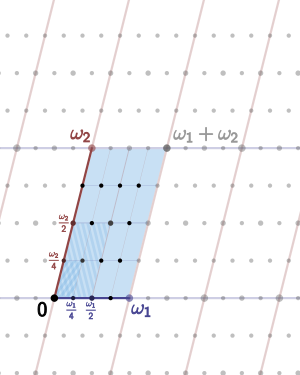Torsion (algebra)
In
This terminology is more commonly used for modules over a domain, that is, when the regular elements of the ring are all its nonzero elements.
This terminology applies to abelian groups (with "module" and "submodule" replaced by "group" and "subgroup"). This is allowed by the fact that the abelian groups are the modules over the ring of integers (in fact, this is the origin of the terminology, which was introduced for abelian groups before being generalized to modules).
In the case of groups that are noncommutative, a torsion element is an element of finite order. Contrary to the commutative case, the torsion elements do not form a subgroup, in general.
Definition
An element m of a
A module M over a ring R is called a torsion module if all its elements are torsion elements, and
More generally, let M be a module over a ring R and S be a
An element g of a group G is called a torsion element of the group if it has finite order, i.e., if there is a positive integer m such that gm = e, where e denotes the identity element of the group, and gm denotes the product of m copies of g. A group is called a torsion (or periodic) group if all its elements are torsion elements, and a torsion-free group if its only torsion element is the identity element. Any abelian group may be viewed as a module over the ring Z of integers, and in this case the two notions of torsion coincide.
Examples
- Let M be a free module over any ring R. Then it follows immediately from the definitions that M is torsion-free (if the ring R is not a domain then torsion is considered with respect to the set S of non-zero-divisors of R). In particular, any free abelian group is torsion-free and any vector space over a field K is torsion-free when viewed as a module over K.
- By contrast with example 1, any Burnside's problem, conversely, asks whether a finitely generated periodic group must be finite? The answer is "no" in general, even if the period is fixed.
- The torsion elements of the multiplicative group of a field are its roots of unity.
- In the conjugateto the element S or has order three and is conjugate to the element ST. In this case, torsion elements do not form a subgroup, for example, S · ST = T, which has infinite order.
- The abelian group Q/Z, consisting of the rational numbers modulo 1, is periodic, i.e. every element has finite order. Analogously, the module K(t)/K[t] over the ring R = K[t] of polynomials in one variable is pure torsion. Both these examples can be generalized as follows: if R is an integral domain and Q is its field of fractions, then Q/R is a torsion R-module.
- The torsion subgroup of (R/Z, +) is (Q/Z, +) while the groups (R, +) and (Z, +) are torsion-free. The quotient of a torsion-free abelian group by a subgroup is torsion-free exactly when the subgroup is a pure subgroup.
- Consider a linear operator L acting on a finite-dimensional vector space V over the field K. If we view V as an K[L]-module in the natural way, then (as a result of many things, either simply by finite-dimensionality or as a consequence of the Cayley–Hamilton theorem), V is a torsion K[L]-module.
Case of a principal ideal domain
Suppose that R is a (commutative) principal ideal domain and M is a finitely generated R-module. Then the structure theorem for finitely generated modules over a principal ideal domain gives a detailed description of the module M up to isomorphism. In particular, it claims that
where F is a free R-module of finite
Torsion and localization
Assume that R is a commutative domain and M is an R-module. Let Q be the field of fractions of the ring R. Then one can consider the Q-module
obtained from M by
which is a module over the
Torsion in homological algebra
The concept of torsion plays an important role in
Abelian varieties

The torsion elements of an abelian variety are torsion points or, in an older terminology, division points. On elliptic curves they may be computed in terms of division polynomials.
See also
- Analytic torsion
- Arithmetic dynamics
- Flat module
- Annihilator (ring theory)
- Localization of a module
- Rank of an abelian group
- Ray–Singer torsion
- Torsion-free abelian group
- Universal coefficient theorem
References
- ^ Roman 2008, p. 115, §4
Sources
- Ernst Kunz, "Introduction to Commutative algebra and algebraic geometry", Birkhauser 1985, ISBN 0-8176-3065-1
- Irving Kaplansky, "Infinite abelian groups", University of Michigan, 1954.
- Michiel Hazewinkel (2001) [1994], "Torsion submodule", Encyclopedia of Mathematics, EMS Press
- MR 2278849
- ISBN 978-0-387-72828-5.






